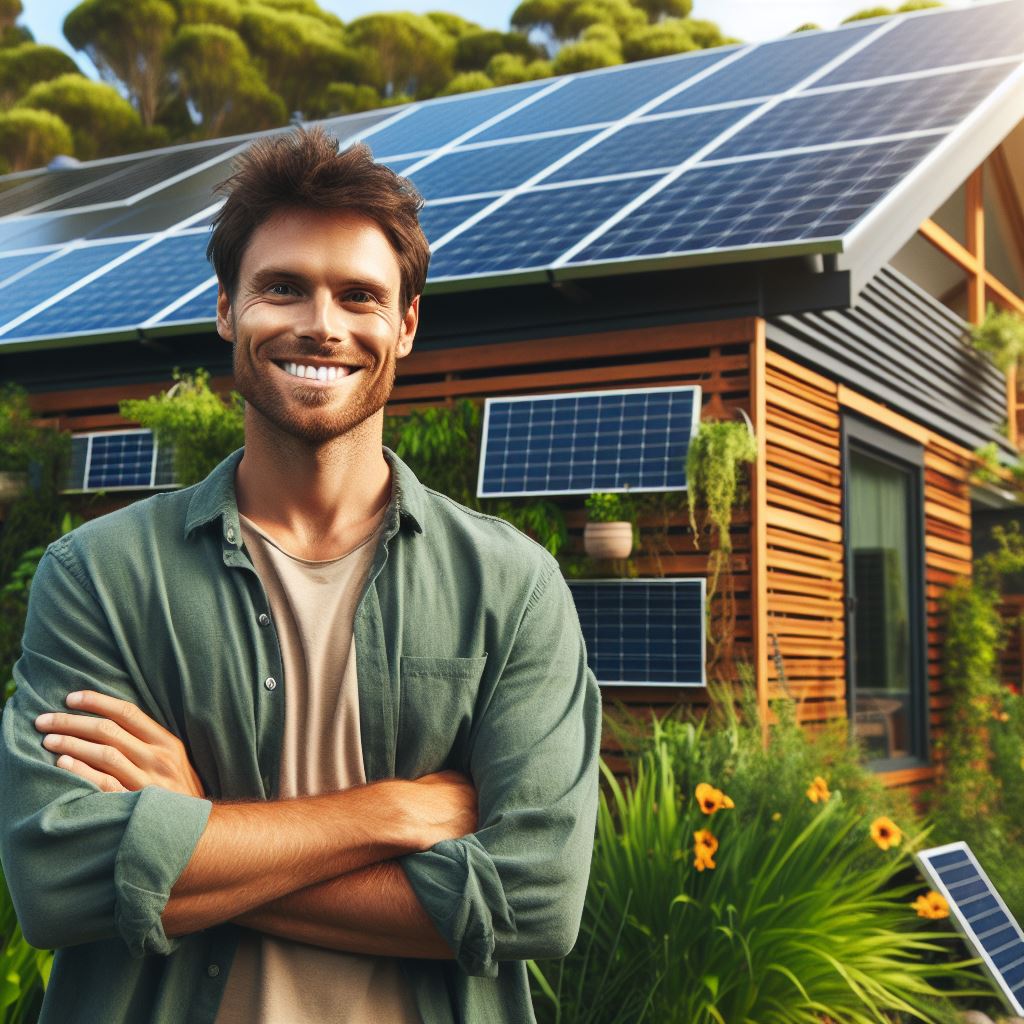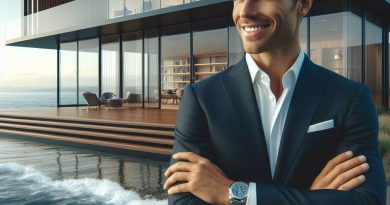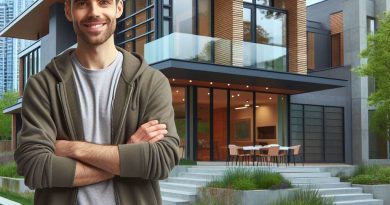Green Roofs: Are They Worth It?
Last Updated on March 6, 2024
Introduction
Green roofs, also known as rooftop gardens, are becoming increasingly popular in urban areas.
These innovative and sustainable solutions offer a range of benefits to both the environment and the people living in and around these buildings.
The concept of green roofs involves transforming the traditional urban landscape by adding layers of living vegetation on top of buildings.
This practice not only enhances the aesthetic appeal of the area but also provides numerous ecological advantages.
It helps mitigate the heat island effect, reduces stormwater runoff, improves air quality, and enhances biodiversity.
The popularity of green roofs has been growing rapidly in recent years.
Cities around the world are embracing this concept as a way to combat climate change and improve the well-being of their residents.
The demand for green roofs is driven by the increasing awareness of environmental issues and the desire for sustainable living solutions.
This post aims to assess the value and benefits of green roofs.
By analyzing the environmental, economic, and social impacts, we can determine if green roofs are truly worth the investment.
The following sections will explore the ecological advantages, economic considerations, and potential challenges associated with green roof implementation.
In essence, green roofs have gained popularity due to their numerous benefits.
They provide sustainable solutions for urban areas, improving the quality of life for both humans and the environment.
This post will delve deeper into the value and advantages of green roofs, allowing readers to understand their potential and make informed decisions.
Environmental Benefits
Reduction of urban heat island effect
Green roofs are highly effective in reducing the urban heat island effect.
The vegetation and soil on these roofs absorb heat and provide a cooling effect to the surrounding environment.
Not only do they regulate temperature, but they also minimize the need for air conditioning, reducing energy consumption.
Improvement of air quality
Another significant environmental benefit of green roofs is the improvement of air quality.
The plants and soil on these roofs act as natural filters, removing pollutants and particulate matter from the air.
Green roofs contribute to reducing air pollution and creating a healthier living environment for urban dwellers.
Reduction of stormwater runoff
Green roofs play a vital role in mitigating stormwater runoff.
They absorb rainwater, preventing it from flowing directly into the sewer system and overwhelming it during heavy rain events.
By reducing stormwater runoff, green roofs help alleviate the strain on drainage systems and decrease the risk of flood damage.
Enhancement of biodiversity and habitats
Green roofs also provide a valuable contribution to biodiversity and habitats in urban areas.
They create green spaces that support various plant species and attract insects and birds.
These roofs act as mini ecosystems, fostering biodiversity and providing habitats for pollinators and other urban wildlife.
In summary, green roofs offer several environmental benefits that make them worth investing in.
They reduce the urban heat island effect by providing a cooling effect and minimizing the need for air conditioning.
Additionally, they improve air quality by acting as natural filters for pollutants.
Green roofs also help reduce stormwater runoff, alleviating strain on drainage systems and minimizing flood risk.
Finally, they enhance biodiversity and create habitats for urban wildlife.
Overall, green roofs are a sustainable solution that can greatly contribute to a healthier and more environmentally friendly urban environment.
Read: Net-Zero Living: A US Overview
Energy Efficiency
A green roof offers several energy-efficient benefits, contributing to reduced energy consumption for cooling and heating.
Decreased energy consumption for cooling and heating
The insulation properties of green roofs help in maintaining stable indoor temperatures, reducing the need for excessive cooling during summers and heating during winters.
The soil and vegetation layers act as natural insulators, preventing heat transfer through the roof and minimizing temperature fluctuations inside the building.
By reducing the energy required for climate control, green roofs help decrease energy consumption, leading to lower utility bills.
Insulation properties and reduction of thermal fluctuation
The layers of plants, soil, and substrate in green roofs provide effective insulation, helping to regulate indoor temperatures.
During hot weather, the green roof absorbs and dissipates the sun’s heat, preventing it from entering the building and reducing the need for air conditioning.
In colder months, the insulation property of the green roof helps in trapping warmth indoors, minimizing heat loss and reducing the reliance on heating systems.
This reduction in thermal fluctuation not only enhances energy efficiency but also improves the overall comfort of the building’s occupants.
Potential savings on utility bills
One of the significant advantages of green roofs is the potential for savings on utility bills.
By reducing the need for excessive heating and cooling, the energy-efficient properties of green roofs can lead to substantial cost savings.
Studies have shown that green roofs can result in energy savings of up to 30%, translating into lower electricity and heating costs for the building owners.
These potential savings on utility bills can make green roofs a worthwhile investment in the long run.
In addition to the direct financial benefits, green roofs also contribute to reducing greenhouse gas emissions, promoting sustainability, and enhancing the aesthetic appeal of buildings.
In fact, the energy-efficient advantages of green roofs are worth considering when evaluating their overall benefits.
With decreased energy consumption, insulation properties, and potential savings on utility bills, green roofs prove to be a sustainable and cost-effective option for buildings.
Investing in green roofs not only contributes to a greener environment but also creates a comfortable and energy-efficient space for occupants.
Read: Solar Power in Real Estate Today
Economic Considerations
Initial installation and maintenance costs
Green roofs can be initially expensive to install and require ongoing maintenance to ensure their longevity.
The cost of installing a green roof varies depending on factors such as roof size, design complexity, and location.
Maintenance costs include regular inspections, irrigation, fertilization, and weed control.
Despite these costs, green roofs offer long-term benefits that can outweigh the initial investment.
Financial incentives and tax benefits
In some regions, there are financial incentives and tax benefits available for green roof installations.
Government programs may offer grants or rebates to offset the installation costs.
Tax credits or deductions can also be applied to reduce the overall tax burden.
These incentives make green roofs more financially feasible for property owners.
Long-term savings on energy and repair expenses
Green roofs provide insulation, reducing the need for heating and cooling in buildings.
This insulation effect results in energy savings and lower utility bills over time.
Additionally, green roofs protect the underlying roof membrane, extending its lifespan and reducing repair expenses.
These long-term savings contribute to the overall economic value of green roofs.
Increased property value and market appeal
Properties with green roofs have higher market value and increased market appeal.
Green roofs enhance the aesthetic appeal of buildings and create a desirable living or working environment.
Investing in a green roof can attract potential buyers or tenants and increase property value.
Furthermore, properties with green roofs are seen as environmentally friendly, positively influencing the property’s market perception.
In short, while installing and maintaining green roofs entail initial costs, these investments can be financially beneficial in the long run.
Financial incentives and tax benefits further enhance the economic feasibility of green roofs.
The long-term savings on energy and repair expenses, along with the increased property value and market appeal, add to their economic value.
Considerations of these economic factors make green roofs a worth-it choice for property owners.
Read: Eco-Friendly Urban Living Trends

Health and Well-Being Benefits
When it comes to green roofs, the benefits extend beyond just the environment.
These innovative rooftops provide numerous advantages for our health and well-being.
Noise reduction and sound insulation
Green roofs act as natural sound barriers, reducing noise pollution significantly.
The layers of vegetation, soil, and other materials absorb and block sound waves, creating a quieter living or working environment.
Furthermore, the vegetation on green roofs helps to insulate buildings, reducing the transmission of sound from outside to inside.
This sound insulation can contribute to a more peaceful and serene atmosphere in urban areas.
Improved mental health and stress reduction
Research has shown that access to green spaces and natural environments can improve mental health and well-being.
Green roofs offer a unique opportunity to connect with nature, even in densely populated cities.
Being surrounded by plants and greenery has a calming effect, reducing stress and anxiety levels.
Spending time on a green roof can provide a retreat from the hustle and bustle of daily life, allowing individuals to relax and unwind.
Enhanced outdoor spaces for relaxation and social interaction
Green roofs can serve as valuable outdoor spaces, providing opportunities for relaxation and social interaction.
These rooftop gardens offer a peaceful escape where individuals can enjoy nature without leaving the building.
Whether it’s a small seating area, a walking path, or a community garden, green roofs create inviting spaces for people to gather, socialize, and engage with their surroundings.
These interactions can foster a sense of community and improve overall well-being.
Potential positive effects on productivity and creativity
Studies have suggested that exposure to natural environments can enhance productivity and creativity.
Green roofs provide a unique setting where individuals can find inspiration and focus while being surrounded by nature.
The presence of greenery and the calming ambience of green roofs can improve cognitive function, attention span, and problem-solving abilities.
This can benefit employees, students, and individuals engaged in creative pursuits, leading to increased productivity and innovation.
In short, green roofs not only contribute to a sustainable future but also offer significant health and well-being benefits.
From reducing noise pollution to improving mental health and providing outdoor spaces for relaxation and social interaction, these innovative rooftops have a positive impact on individuals and communities.
By creating serene environments and fostering connections with nature, green roofs contribute to a healthier and happier society.
The potential positive effects on productivity and creativity further highlight the value of integrating green spaces into our urban landscapes.
Investing in green roofs is indeed worth it, as they promote not only environmental sustainability but also our overall well-being.
Read: 2024’s Top Green Home Features
Potential Drawbacks
Structural considerations and weight load
Green roofs can add considerable weight to a building, requiring structural modifications.
Extra reinforcement may be needed to support the added load, which can increase construction costs.
Older buildings may not have the capacity to support the weight of a green roof.
Maintenance requirements and costs
Green roofs require regular maintenance, including watering, weeding, and pruning.
The costs of maintaining a green roof can be higher compared to traditional roofs.
Specialized equipment and professionals may be needed for proper upkeep, adding to the expenses.
Limited applicability in certain climates or building types
Green roofs may not be suitable for areas with extreme temperatures or high winds.
In hot climates, the added insulation of green roofs can increase indoor cooling demands.
Certain building types, such as high-rise structures, may pose challenges for green roof installation.
In general, while green roofs offer numerous benefits, there are also potential drawbacks that need to be considered.
Structural considerations and weight load can lead to increased construction costs and may be problematic for older buildings.
Maintenance requirements and costs are higher compared to traditional roofs and may require specialized equipment and professionals.
Moreover, green roofs may have limited applicability in certain climates or building types.
Despite these drawbacks, it is important to weigh the potential disadvantages against the benefits to determine if green roofs are worth it for a specific project or location.
Case Studies and Success Stories
Successful green roof projects
- The High Line in New York City: The transformation of an abandoned elevated railway into a stunning green space.
- Chicago City Hall: The first green roof in the city, reducing energy costs and stormwater runoff.
- The California Academy of Sciences: A living roof showcasing biodiversity and reducing energy consumption.
- The Target Center in Minneapolis: A unique green roof providing a sustainable solution for a sports facility.
Positive impacts on various types of buildings
- Residential buildings: Green roofs can reduce energy consumption, create a peaceful oasis, and increase property value.
- Commercial buildings: Green roofs can attract clients and tenants, lower energy costs, and contribute to corporate sustainability goals.
- Educational institutions: Green roofs provide outdoor learning spaces, improve air quality, and reduce the urban heat island effect.
- Hospitals: Green roofs offer therapeutic views for patients, improve indoor air quality, and reduce noise pollution.
Financial and environmental benefits experienced
- Financial benefits: Green roofs can increase the lifespan of roofs, reduce HVAC costs, and attract grant funding or tax incentives.
- Energy savings: Green roofs insulate buildings, reducing the need for heating and cooling, resulting in lower energy bills.
- Stormwater management: Green roofs absorb rainwater, reducing the burden on sewage systems and preventing flooding.
- Biodiversity and air quality: Green roofs support plant and animal species, improve air quality by filtering pollutants, and generate oxygen.
In review, case studies and success stories demonstrate the worth of green roofs.
These projects highlight successful transformations of buildings, positive impacts across various sectors, and the financial and environmental benefits experienced.
Green roofs are not only visually appealing but also contribute to sustainability efforts, improve air quality, reduce energy consumption, and provide additional green spaces in urban environments.
The success stories serve as inspiration for future green roof projects and showcase the potential benefits for building owners, communities, and the environment.
Conclusion
Green roofs offer numerous benefits, such as improved stormwater management, energy savings, and enhanced biodiversity.
However, they also come with drawbacks like high installation and maintenance costs.
Despite the drawbacks, green roofs are highly valuable and significant in promoting sustainability.
They contribute to urban heat island mitigation, air quality improvement, and overall urban well-being.
It is important for individuals and communities to explore the potential of green roofs as a sustainable solution.
Further research and innovation in green roof technology can lead to even more benefits and decreased costs.
By implementing green roofs on a larger scale, we can create a greener, healthier, and more sustainable future for our cities and the environment as a whole.


